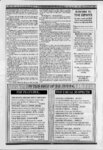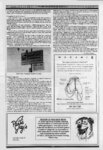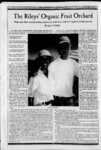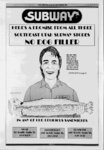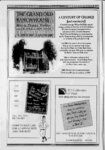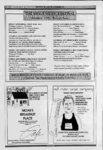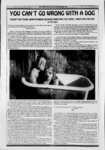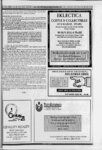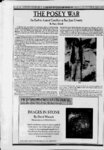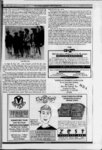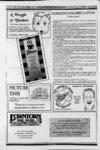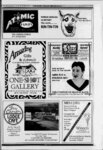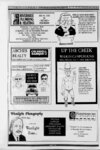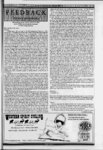| OCR Text |
Show 6 THE U.S. FOREST SERVICE INTEGRITY BY OWEN SEVERANCE EDITOR'S NOTE: This is the first in a southeast Utah. series on the multi-pa-rt US. Forest Service in INTEGRITY. Definition: Moral soundness; honesty; uprightness. (Webster's New Collegiate Dictionary) INTE GRITY-NODefinition: The United States Forest Sendee. (Actions speak louder than words) T. like to consider myself an optimist - at least most of the time. When a Federal Agency undergoes personnel turnover at significant positions, I always hope that the new bodies will be an improvement over the previous occupants of those positions. Unfortunately, I am almost always disappointed. Two of these changes occurred recently for the Manti-LaSNational Forest in Southeastern Utah. The new Forest Supervisor arrived last year and the acting District Ranger for the newly combined MoabMonticello Ranger District was appointed to the position so he no longer has to use the term "acting." Most Forest decisions are initiated at the Ranger District level and then approved by the Forest Supervisor; these two positions have the primary responsibility for determining the future of the National Forest on the LaSal and Abajo Mountains. I've spent a lot of time in the last eleven years trying to convince the Forest Service that values such as scenery, should be protected on the Manti LaSal National Forest I haven't had much success. The decisions made so far by the new Forest Supervisor indicate that once again commodity values on the Forest will have priority over other forest uses that do not have an obvious dollar value. Generally speaking, anything that the Forest Service can sell, lease, or require a permit for is a commodity. Grass, trees I al non-commod- ity : Hi pi climax species of tall forb vegetation communities, and grazing has not increased its density or distribution." This means that Larkspur is a natural part of the environment on the La Sal Mountains and supposedly has not increased because of past overgrazing on the Forest The reason the grazing permittees want it destroyed is obvious; the reason the Division of Wildlife Resources wants it eliminated is less obvious until you realize that much of the Division's budget comes from the sale of hunting licenses. If huntable game increases, more hunting licenses can be sold and the Division will have more money to spend on promoting hunting. Therefore the Division of Wildlife Resources uses the same equation as the grazing permittees - less Larkspur equals more money. So who speaks for the flowers? Certainly not the Forest Service. The agency readily agreed to "control" Larkspur. The Environmental Assessment stated: "Larkspur will never be eradicated, but if the density of this toxic plant could be reduced, cows might not find enough to cause death." Why not just keep cows away from Larkspur during the relatively short period of time when it is toxic to cows? The Environmental Assessment dismissed this option in the section titled "Alternatives Eliminated From Detailed Consideration." An alternative to "Control Cattle Loss from Larkspur Poisoning by means of Livestock Management only was rejected because of "its lack of practical use as a tool to control livestock poisoning." In other words, it is unacceptable to fence cows out of areas with Larkspur because the Forest Service wants every possible acre of the forest to be used for cow feed. So don't expect to see areas of flowering Larkspur on the LaSals when the Forest Service finishes "controlling this native plant Instead, just try to visualize its blue flowers every time Oil '1 , (for lumber or firewood), high points (for communications sites), developed campgrounds, and land suitable for ski areas are examples of commodity values. value. Anything that the Forest Service can't charge a fee for is a Dispersed recreation (hiking, camping, horseback riding, mountain biking, crosscountry skiing, etc when it takes place outside of developed recreation areas) and the Forest's scenery (whether enjoyed from on or off the Forest) are examples. Unfortunately, commodity values have been determined by the Forest Service to be more important than just allowing people to enjoy the forest as it is. If you want to make a buck from the forest, the Forest Service will welcome you with open arms. If you are interested in other values, don't expect the same reception. non-commod- LARKSPUR: THE EVIL WEED The first significant decision by Janette Kaiser, the new Forest Supervisor, that affected the MoabMonticello Ranger District concerned those nasty, despicable, poisonous (to cows) plants on the LaSal Mountains known as Larkspur. (The domesticated version of this flower is the Delphinium.) Most casual visitors to the Forest consider these native plants with attractive blue flowers to be a colorful addition to the landscape. Ranchers consider them to be evil; something that must be eradicated for the safety of their not too bright livestock. And the Utah Division of Wildlife Resources agrees, saying that wildlife habitat would if Larkspur is "improve "controlled." The Environmental Assessment for the proposal to "control" Larkspur on the Moab Ranger District includes the following information: "tall larkspur is a -- S" .&"& 4 . you see a cow. (For some reason this reminds me of the time that one of the grazing permittees tried to have the size of the Elk herd on the LaSals reduced because the Elk were eating the forage that "belonged" to his cows.) It is unfortunate that the Forest Service is so willing to do what the grazing permittees want since the fees charged for grazing don't even cover the costs of managing grazing on the Forest. And the fees are embarrassingly low to those who believe in the free market system and oppose government subsidies to special interest groups. I assume most ranchers belong in this category - but don't expect to see the grazing permittees offering to pay market value for the grass their cows eat. It's only other peoples' subsidies that they oppose. THE EGREGIOUS TIMBER SALE The next egregious decision by the Forest Supervisor concerned a timber sale on the LaSals. (For those of you who don't want toby to find your dictionaries, the word egregious meins "outstandingly bad." It is a good word. Use it at every opportunity when commenting on documents written by Federal agencies.) With this proposed sale, the Forest Service has gone back to its old mantra, "trust us." Under this mind set, the Forest Service does not allow the public to be full participants in the decision making process; the public is given minimal documentation for proposals and the decisions made by the Forest Service "professionals" ignore public concerns. The "trust us" policy didn't work in the past and won't work now. I quit trusting the Forest Service a long time ago when I found out that a commitment lasts only as long as the person who made it is around to honor it. The rationale for the "Willow Basin Fire Recovery Project" was a fire that occurred in June of 1994. The Scoping Notice for this proposal says very little. Statements like: "The purpose of the proposed action is to reduce the number of fire killed or damaged trees that will otherwise act as catalysts for insect and disease build-u- p and to bring the Recovery Project Area toward the Desired Fiiture Condition" are as generic as possible and give little information to the public For example, the size of the sale was not discussed in the Scoping Notice. The decision was also made to handle this sale as a "Categorical Exclusion" which meant an Environmental Assessment would not be prepared. The public would only have the information in the Scoping Notice to comment on. When I finally received the Forest Service's response to comments on the Scoping Notice, I was amazed. They "Considered and Resolved" 83 comments on this proposal and two proposed sales on the Monticello Ranger District with responses that usually Ignored the point of the comment So much for public |


